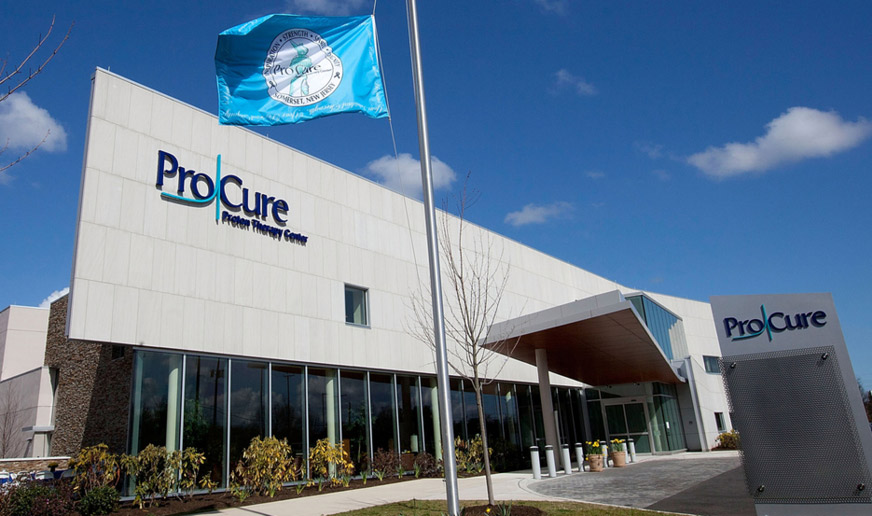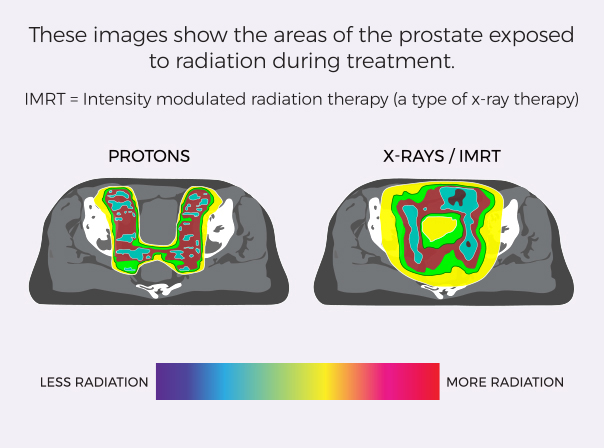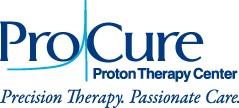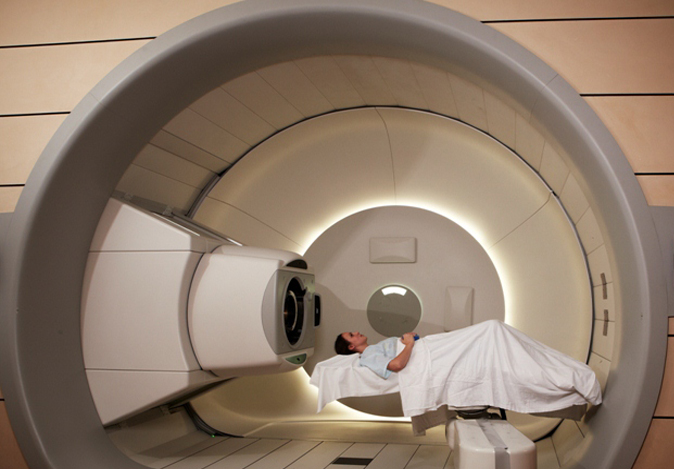What Is Proton Therapy?
Find Your Answer Here
Proton Therapy at ProCure
What Is Proton Therapy?
Proton Therapy is an innovative means of cancer treatment that delivers radiation at exact depths to precisely target tumors. Much of the radiation is deposited exactly at the tumor site and then stops, reducing excess radiation to healthy tissue.
Like standard X-ray radiation, proton therapy destroys cancer cells by preventing them from dividing and growing. But unlike the photons used in standard radiation therapy, proton therapy uses positively charged atomic particles—known as protons—to target cancer cells with greater accuracy and no exit dose.
With proton therapy, a higher radiation dosage can be delivered to the tumor site while minimizing exposure to surrounding healthy organs and tissue.
Precision Targeting. Fewer Side Effects.
A highly advanced form of radiation treatment, proton therapy destroys cancer cells with the utmost precision while sparing surrounding healthy tissue.
Proton therapy effectively targets cancer and reduces the risk of serious side effects, making it ideal for all types of cases, including complex cases and recurrent tumors, and as a complement to other treatments such as surgery or chemotherapy.
Pencil Beam Scanning Technology
Pencil Beam Scanning (PBS) is a revolutionary technology that boosts accuracy with its ultra-narrow proton radiation beam. Pencil Beam Scanning effectively ‘paints’ the tumor with radiation in three dimensions by moving a proton beam of pencil-point sharpness back and forth across each layer of the tumor. This extreme precision allows the radiation dose to conform to the specific shape and size of the tumor, making it ideal for irregularly shaped tumors located near critical organs and tissues.

ProCure is the first center in New Jersey to offer Pencil Beam Scanning (PBS) and was the first center in the tri-state area to treat patients with this technology.

Proton Therapy vs. Standard Radiation
Proton therapy and standard X-ray radiation are both types of radiotherapy that destroy cancer cells by preventing them from dividing and growing. The difference, however, is in their delivery. Protons are subatomic particles that can be controlled to deliver their radiation at exact depths. Much of their radiation is deposited exactly at the tumor site and then stops.
Standard X-ray radiation beams, on the other hand, release radiation from the moment it penetrates the skin all the way through to the other side of the tumor. With radiation interacting with healthy cells throughout the beam’s path, the potential for damage to surrounding tissues and organs is greater.
Why Choose Proton Therapy
Ultra-Precise
Radiation is delivered directly into the tumor and stops, maximizing cancer cell dosage and minimizing damage to healthy tissue.
Fewer Side Effects
With no exit dose, surrounding healthy tissue and organs are spared from radiation. Both short and long-term side effects are minimized.
Fast Treatment with Minimal Recovery Time
Each treatment session lasts around 30 minutes, and with fewer side effects than standard X-ray and traditional cancer treatments, most patients can continue on with their daily lives with little interruption.
Ideal for Many Tumor Types
The ultra-precision of proton therapy makes it ideal for even the most complex of cases. Tumors that are irregularly-shaped, difficult-to-reach, close to vital organs or recurrent following prior treatment can be targeted with the utmost accuracy.
Lower Odds of Secondary Tumors
Proton therapy reduces the risk of secondary tumors compared to conventional X-ray radiation therapy.
Effective for Children and Adults
Less invasive and with minimal side effects, proton therapy is an effective treatment for both children and adults.
Proton Therapy History
The first patient received treatment with protons more than 50 years ago, and the U.S. Food and Drug Administration (FDA) approved proton therapy as a radiation treatment option in 1988. To date, more than 180,000 people worldwide have received proton therapy at cancer centers in Europe, Asia, and the United States.
Proton Therapy Timeline
1919: British physicist Ernest Rutherford demonstrates the existence of protons (elementary particles found in atoms).
1946: Physicist Robert Wilson first proposed that protons could be used to deliver an increased dose of radiation to a tumor while simultaneously decreasing the exposure of surrounding healthy tissue to radiation.
1950: The first research trials were conducted on patients in the US and Europe. Results were promising, but the inability of imaging technology to accurately “see” or locate many tumors and the inability to direct protons to sites deep within the body meant that only a few patients were appropriate candidates for the treatment.
1980s: Advances in imaging technology, including CT, MRI, and PET scans, help researchers to better diagnose and “see” tumors, making proton therapy—which requires identifying the precise location of a tumor—a more practical treatment option.
Today: Advances in imaging, CT, MRI, and PET scans now allow physicians to “see” deep inside the body and precisely define the location, size, and shape of tumors. This capability, coupled with improvements in proton technology, brought about today’s growing interest in proton therapy as an important treatment option for cancer.
Talk To Us
Find out if proton therapy is the right treatment for you. Contact our Care Team or request more information online.
Attend An Information Session
Learn more about proton therapy and our world-class Care Team. Contact the center to reserve your place.








